Minoans and Mycenaeans
The Minoans and Mycenaeans were two ancient civilizations that existed in Greece during the Bronze Age. The Minoans were known for their advanced art and architecture, while the Mycenaeans were known for their military prowess and conquests. Both civilizations had a significant impact on Greek history and culture, and their legacy can still be seen today in archaeological sites and artifacts.
The Minoans and Mycenaeans play an important role in ancient Greek history. The two different civilizations helped develop ancient Greece.
Minoans were in power from 2600 B.C.E. until 1400 B.C.E. and lived on the Greek islands. They constructed a large palace on the island of Crete.
The Mycenaeans lived from 1600 B.C.E. until 1100 B.C.E. They occupied the mainland area of Greece.
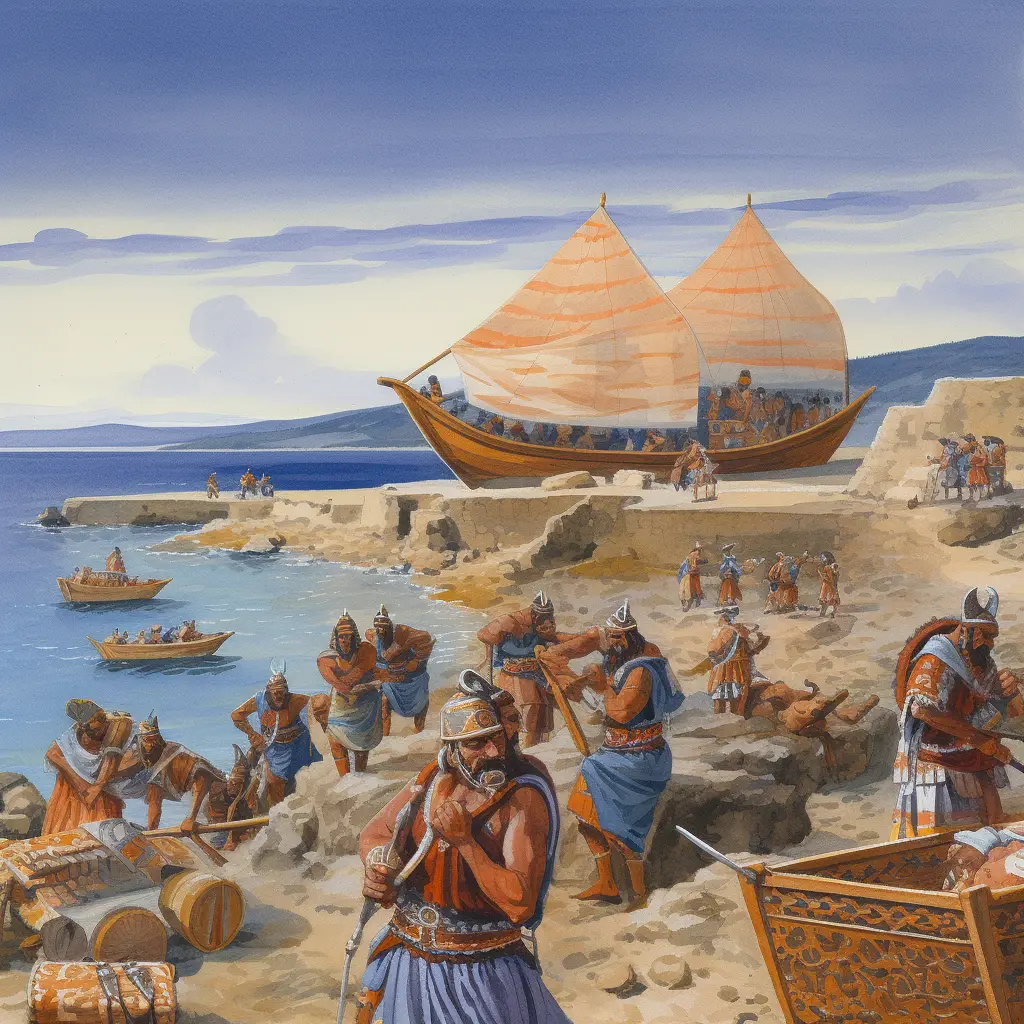
Minoans and Mycenaeans Facts
- Minoans lived on Crete, an island in Greece.
- Mycenaeans came from mainland Greece, not an island.
- Minoans’ art often depicted dolphins and other sea life.
- Mycenaeans built massive ‘beehive’ tombs for leaders.
- Minoans had a form of writing called ‘Linear A’.
- Mycenaean writing, ‘Linear B’, was used for record-keeping.
- Mycenaeans took over Crete around 1400 BC, ending the Minoan era.
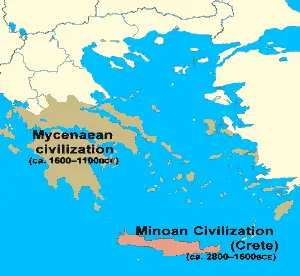
The Minoans
The Minoans were an advanced civilization that constructed a large navy. The navy was useful for protection and trading goods. They were ruled by a king with a central government. The capital city of the Minoans was called Knossos and was located on the island of Crete.
The palace for the Minoan kings in Knossos was huge with 1,500 rooms and each room had its own bathroom. Greek mythology claims one king named Minos built a large maze beneath the palace to house a beast called Minotaur.
The beast was half-man and half-bull. The Minoans were an advanced culture with a written language named Linear A.
Minoan Civilization: Art, Trade, and Natural Disasters
The ancient homes found on Crete contained beautiful art and statues, and there was running water for drinking and bathing. The Minoans created a large agricultural system based on olives and grapes which they used in trade for bronze and ivory.
The Minoan kings were also generous to the people and shared wealth throughout the Minoan region. Even poor Minoans had lavish homes. The Minoan civilization was affected many times by natural disasters that occurred.
The disasters included erupting volcanoes, tidal waves, and earthquakes. After each natural disaster, the Minoans rebuilt homes and palaces. Researchers believe that natural disasters helped with the decline of the Minoan culture.
Bronze Age Civilizations
The Minoans emerged around 3000 BCE on Crete, marking a significant period in Bronze Age history. Renowned for their maritime capabilities, they established robust trade networks across the Mediterranean, which played a vital role in cultural exchange during this era. With their distinct Linear A script, they contributed to the early development of writing systems.
The Minoan civilization is notable for its unique art forms, like vibrant frescoes, and advanced architectural designs, represented by the Palace of Knossos. Although the civilization fell around 1450 BCE, possibly accelerated by natural disasters like the Thera eruption, their influence persisted, shaping the evolution of the subsequent Mycenaean civilization.
Linear A Script

Linear A, emerging around 1800 BCE, is a significant but undeciphered script system linked to the Minoan civilization of Bronze Age Crete. It was used widely across various mediums such as clay tablets and sealing stones, suggesting its importance in administration, commerce, and potentially religion. Although its specific language remains unknown, the script comprises hundreds of signs, some of which were adopted by the succeeding Mycenaean civilization for their Linear B script.
Despite being undeciphered, Linear A reflects the complexity of Minoan society and provides potential avenues to uncover insights about their culture, economy, and beliefs. As such, it remains a point of fascination among scholars and stands as a testament to the rich Minoan cultural heritage.
Palace of Knossos
The Palace of Knossos, a key architectural landmark in Crete, exemplifies the grandeur of the Minoan civilization during the Bronze Age. Constructed around 2000 BCE, the palace complex displays the Minoans’ advanced urban planning and construction skills. Beyond being a royal residence, it functioned as a multi-purpose hub, housing administrative centers, religious spaces, and workshops.
The vibrant frescoes within its walls depict scenes of daily life and rituals, providing insights into Minoan society. Features such as plumbing systems and light wells demonstrate their engineering sophistication. Despite enduring earthquakes and reconstructions, Knossos remained significant, reflecting Minoan resilience.
Early 20th-century excavations by Arthur Evans unveiled its marvels, marking it as a key site for understanding Minoan history and culture.
Minoan Art and Pottery
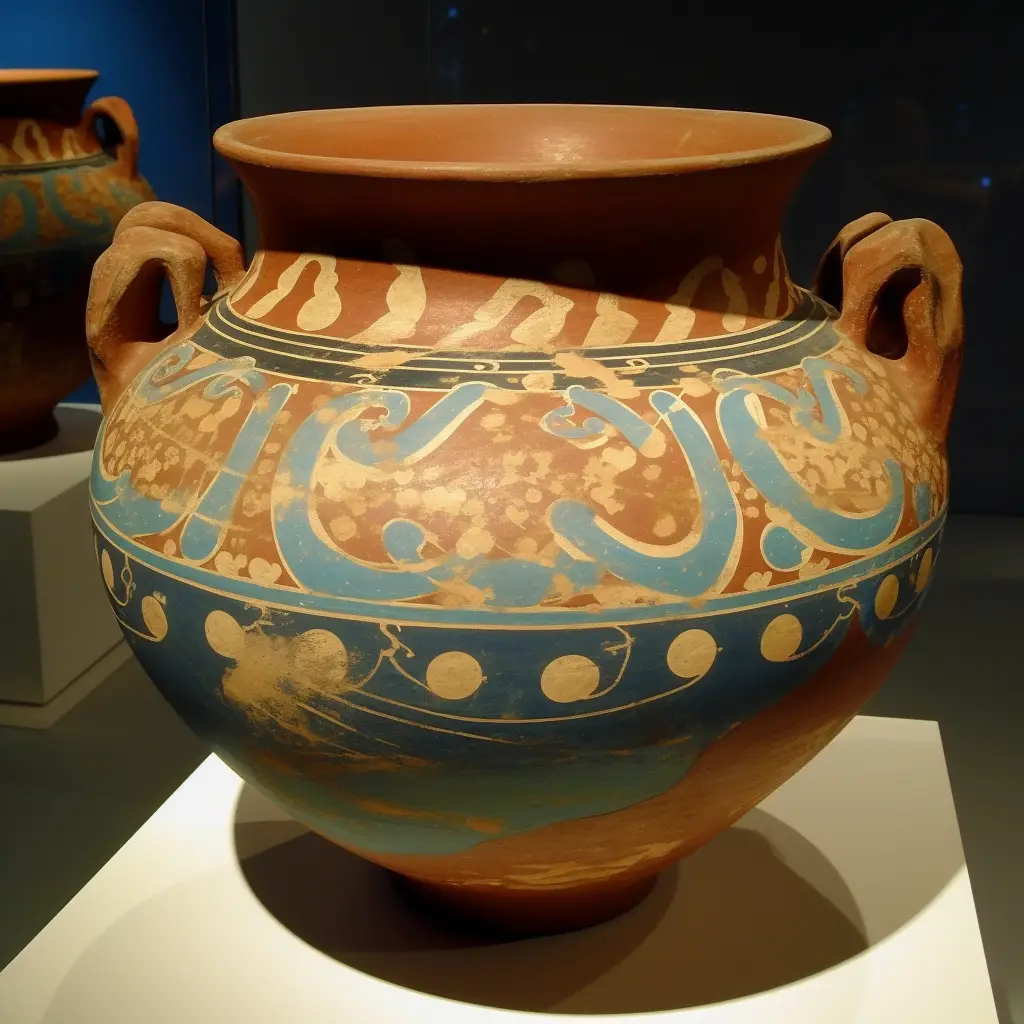
Minoan art and pottery, integral aspects of the Minoan civilization in Bronze Age Crete, offer valuable insights into their culture. Known for their naturalistic designs, dynamic compositions, and vibrant colors, Minoan art encompasses frescoes that depict scenes from nature, daily life, and religious practices.
Minoan pottery, distinguished by its elegance and variety, ranges from the intricate Kamares ware to the Marine Style, which features detailed depictions of sea life. These shifts in pottery style mirror changes in Minoan society and their maritime environment.
As a whole, Minoan art and pottery provide a window into their beliefs, social structures, and daily experiences.
Aegean Sea Trade and Maritime Activities
During the Bronze Age, the Minoans of Crete were known for their seafaring skills and widespread trade networks across the Aegean Sea and further afield. Their geographical position enabled trade and cultural exchanges with diverse civilizations.
Minoan vessels reached the broader Mediterranean region, and possibly as far as Egypt and the Near East, transporting goods such as pottery, olive oil, and precious metals. The discovery of Minoan artifacts in distant lands signifies their far-reaching trade routes. Additionally, their advanced shipbuilding skills and harbors cemented their status as a major maritime power.
Hence, Minoan trade and maritime activities were crucial in shaping the socio-economic landscape of the Bronze Age Aegean and influenced early civilization interconnectivity.
Minoan Religion
Minoan religion, a defining aspect of Minoan society during the Bronze Age, centered around nature worship and fertility rites. Though specifics are scarce due to the undeciphered Linear A script, archaeological findings suggest a strong presence of female deities, indicating a possible matriarchal influence in their beliefs.
Iconography frequently portrays a “snake goddess” or “priestess,” implying women’s central role in religious practices. Bull worship is also evident in frescoes and horned altars.
Sacred spaces such as caves, peak sanctuaries, and palaces likely hosted religious ceremonies, underlining religion’s significance in Minoan society. Thus, the exploration of the Minoan religion provides insights into their worldview and societal organization.
Thera Eruption (Santorini) and its Impact
The Thera eruption, around 1600 BCE on Santorini, was a cataclysmic event with profound implications for the nearby Minoan civilization. Its proximity to Crete and immense scale suggest significant impacts on the Minoans. Evidence of volcanic ash over Crete points to environmental disruption, possibly causing crop failures and famine.
Tsunamis triggered by the eruption could have damaged coastal settlements and maritime trade, undermining Minoan economic stability. While there’s debate over whether the eruption directly caused the Minoan civilization’s decline, it likely contributed to its destabilization. This event highlights the susceptibility of ancient societies to natural disasters.
Minoan Architecture
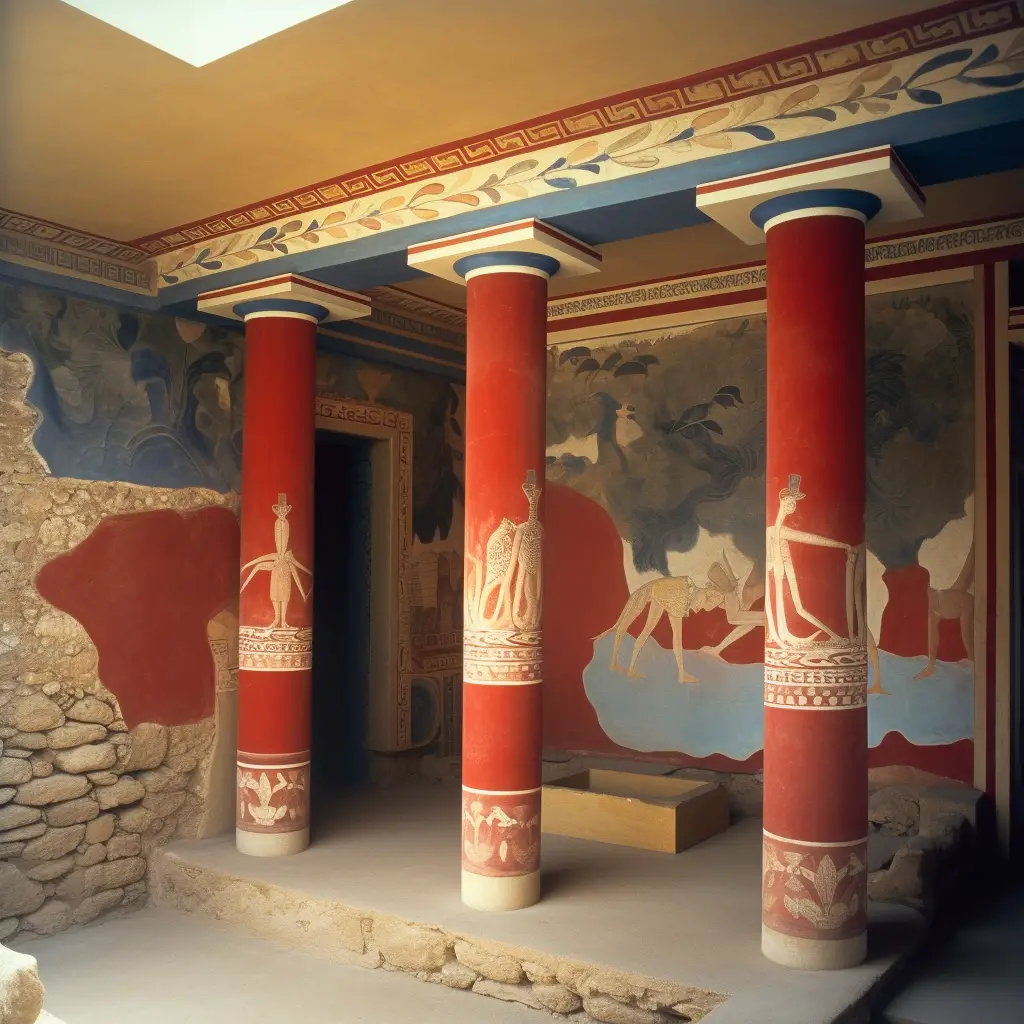
Minoan architecture, notable for its grand palatial complexes in Knossos, Phaistos, and Malia, reflects the sophistication of the Minoan civilization during the Bronze Age. These structures, with their labyrinthine layouts, symbolize the myth of the Minotaur. Minoan buildings often incorporated light wells and drainage systems, demonstrating their advanced urban planning.
They used ashlar blocks, cut from local limestone, which ensured durability and aesthetic appeal. Wall frescoes added artistic richness, while their unique column design became a characteristic Minoan feature. These architectural contributions significantly influenced later Greek architecture, underscoring the Minoans’ lasting cultural impact.
Bull-Leaping Frescoes and Rites
Bull-leaping, prominently featured in Minoan art, likely held significant cultural and religious importance in Minoan society. Frescoes in palaces like Knossos often depict bull-leaping scenes, where a person, possibly a youth, performs acrobatics over a bull.
These images suggest the ritual could have served as a rite of passage, religious ceremony, or entertainment. The prevalence of the bull motif, aligned with other evidence of bull worship in Minoan cultures, such as horned altars, enriches our understanding of Minoan religious practices, societal values, and artistic styles.
Archaeological Exploration of Crete
The archaeological exploration of Crete has played a key role in revealing the Minoan civilization’s history and culture. Beginning in the late 19th century with figures like Sir Arthur Evans, systematic excavation unveiled significant sites like the Palace of Knossos.
Subsequent excavations at Phaistos and Malia yielded valuable artifacts including pottery, frescoes, and scripts, enriching our knowledge of Minoan society. Despite considerable progress, ongoing efforts to decipher Linear A and further excavations continue to promise new insights into this ancient civilization. Thus, the archaeological exploration of Crete underlines the island’s rich historical narrative and the allure of the Minoan civilization.
The Mycenaeans

Mycenaean culture thrived on the mainland of Greece and the Peloponnesian in Southern Greece. The Mycenaeans were a fierce group of people and fought many wars with stone weapons. The Mycenaean kings were much different than the Minoan kings.
They did not share the wealth of people. Instead, the kings would use the money for the military and huge ceremonies celebrating victory or the death of a warrior. The capital city was named Mycenae but there were other Mycenaean cities too such as Athens and Thebes.
The Mycenaeans developed the first spoken language and are sometimes referred to as the First Greeks. They grew a strong navy for protection and trading goods like the Minoans.
They traded goods as far away as Egypt and within the Mediterranean Sea. According to Homer’s Iliad, the Minoans were defeated by the Mycenaeans in the city of Troy.
From Minoans to Dark Ages: The Rise and Fall of Ancient Greece
When the Minoan culture declined the Mycenaeans eventually occupied the mainland and islands of ancient Greece. They also used much of the Minoan culture like adapting the Minoan writing into their language. This writing is named Linear B today.
The Mycenaean culture declined after many of their cities were destroyed. Researchers do not know if this decline was due to natural disasters like an earthquake or if they were conquered by other ancient civilizations like the Dorians or Sea Peoples.
After the decline of the Mycenaean culture, ancient Greek entered into the Dark Ages. The Dark Ages of Greece was a time of famine which led to a reduction in population. The Dark Ages of Greek lasted from 1100 B.C.E. until 800 B.C.E.
Bronze Age Civilizations
The Mycenaeans, a major Greek civilization, flourished during the late Bronze Age, from approximately 1600 to 1100 BC. Their development was influenced by interactions with neighboring societies like the Minoans.
Evidence of this cultural exchange can be seen in Mycenaean architecture and administration. They were also possibly involved in the Late Bronze Age collapse, a period that saw the decline of many regional civilizations.
Trojan War
The Trojan War, a legendary conflict in ancient Greek mythology, is connected to the Mycenaean civilization, a prominent Bronze Age culture in the Aegean region. Set in the late Mycenaean period, the war represents a confrontation between the Mycenaean Greeks and the city of Troy.
As told in Homer’s epic poems, the Iliad and the Odyssey, Mycenaean king Agamemnon led a coalition of Greek forces against Troy to reclaim Helen, the wife of his brother Menelaus. The Trojan War epitomizes Mycenaean warriors’ heroics and the civilization’s influence and alliances.
While its historical accuracy remains debated, the war’s enduring impact reflects the Mycenaeans’ significance.
Linear B
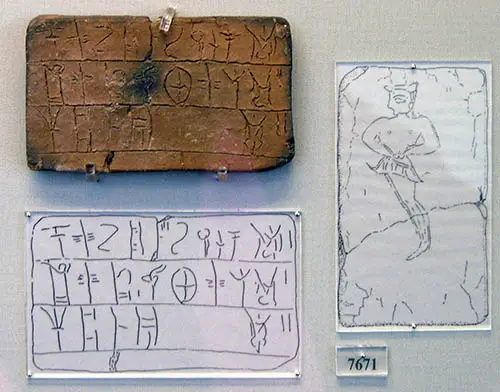
Linear B, a writing system developed around 1450 BCE, is associated with the Mycenaean civilization. An adaptation of the Minoan Linear A script, Linear B was used for administrative purposes and inscribed on clay tablets. The script recorded economic transactions and inventory lists, providing valuable insights into Mycenaean society.
Consisting of roughly 90 syllabic and ideographic symbols, it documented the Mycenaean Greek language, which evolved into classical Greek. Deciphered in 1952, Linear B remains a primary source of knowledge about the linguistic, administrative, and economic aspects of the Mycenaean civilization.
Greek Mythology
Greek mythology shares a strong connection with the Mycenaean civilization, playing a pivotal role in shaping early Greek culture. Many mythological narratives have origins in Mycenaean society and reflect the rulers, warriors, religious beliefs, and customs of the time.
Tales of King Agamemnon and heroes like Achilles, Odysseus, and Hercules are set against the Mycenaean era backdrop. The Greek pantheon, including deities such as Zeus, Poseidon, and Athena, were revered by Mycenaeans, with archaeological evidence of rituals and offerings found in their palatial centers.
The Mycenaean civilization’s contributions to Greek mythology forged an enduring cultural legacy.
Archaeology of Mycenae
The archaeology of Mycenae has been instrumental in revealing the Mycenaean civilization’s rich Bronze Age heritage. Excavations at Mycenae began in the late 19th century under Heinrich Schliemann, who unearthed the “Mask of Agamemnon” and other valuable artifacts. Investigations have revealed the Cyclopean walls, the Lion Gate, and an extensive palace complex within the citadel.
Artifacts, including frescoes, pottery, weapons, and gold, silver, and bronze objects, offer glimpses into Mycenaean artistic, military, and economic prowess. Archaeological findings at Mycenae enhance our understanding of the civilization’s history, belief systems, and societal organization.
Cyclopean Masonry
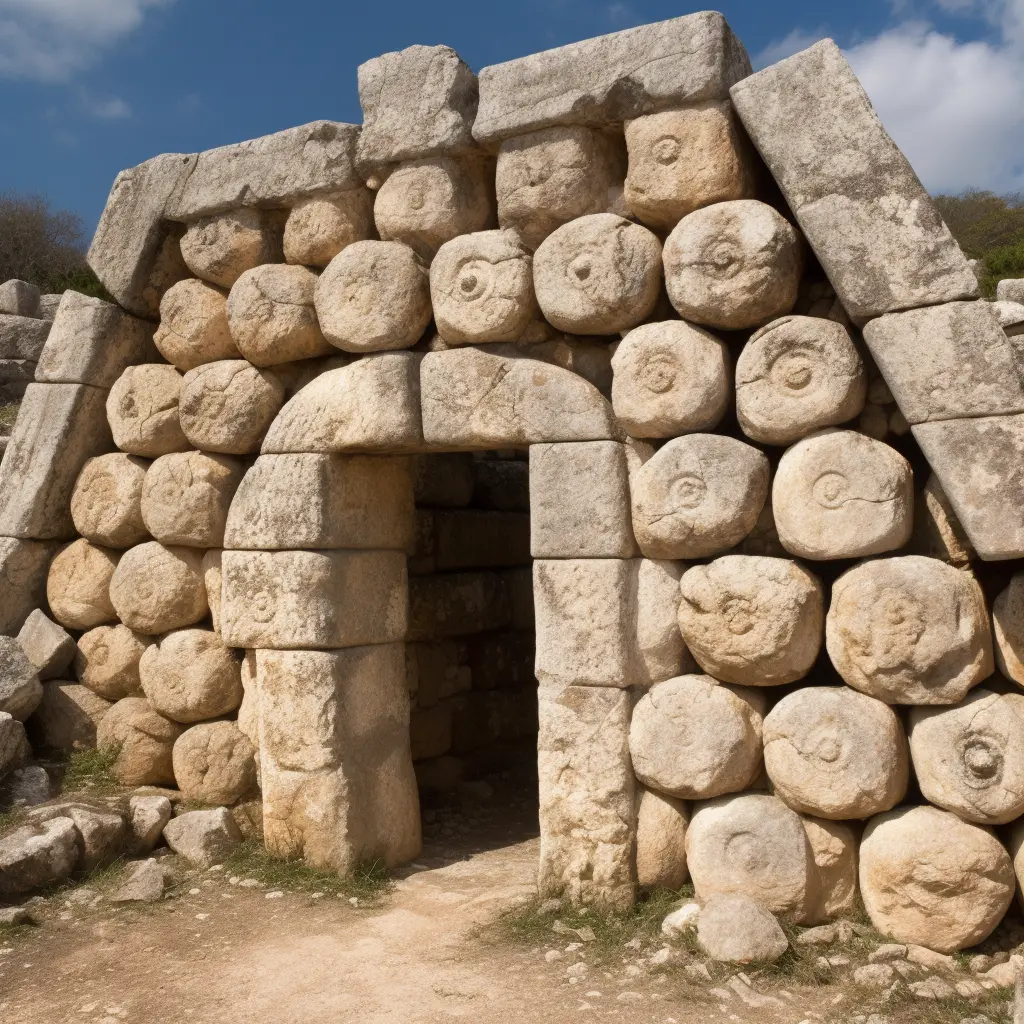
Cyclopean masonry, a distinctive Mycenaean architectural technique, involves using large, irregularly-shaped limestone boulders fitted together without mortar. This technique is found in several Mycenaean sites, including the citadel of Mycenae.
The massive walls served as defensive structures and showcased the Mycenaeans’ engineering prowess. The term “Cyclopean” refers to the one-eyed giants from Greek mythology thought to have built these walls. The iconic Lion Gate is a prime example of Cyclopean masonry in Mycenae.
This architectural style highlights the Mycenaeans’ advancements and their ability to create monumental structures during the Bronze Age.
Late Bronze Age Collapse
The Late Bronze Age Collapse, a period of widespread societal decline and disintegration during the 12th century BCE, had profound implications for the once-thriving Mycenaean civilization. This complex and multifaceted phenomenon, characterized by the destruction and abandonment of several major cities and the disruption of long-established trade networks, spelled the end of the Mycenaean era.
Although the precise causes of the collapse remain a subject of debate among scholars, a confluence of factors is believed to have contributed to the decline, including climatic changes, natural disasters, internal conflicts, political upheaval, and foreign invasions by enigmatic groups, such as the Sea Peoples.
Mycenaean palatial centers, including Mycenae, Pylos, Tiryns, and Thebes, experienced significant destruction and gradually fell into obscurity, with many sites left deserted or repopulated on a smaller scale.
Tholos Tombs
Tholos tombs, or beehive tombs, are significant Mycenaean burial structures from the 15th century BCE. Found in sites like Mycenae, Orchomenos, and Pylos, they have a circular design, corbelled roofs, and monumental entrances.
Built for the elite, these tombs highlight societal hierarchy and wealth. The ornate grave goods found within offer insight into Mycenaean cultural and technological advancements, making them enduring symbols of the Late Bronze Age Aegean world.
Palatial Economy
The palatial economy was central to Mycenaean civilization, controlling wealth, resources, and labor during the Late Bronze Age. Palaces, like those in Mycenae, Pylos, and Tiryns, served as administrative, trade, and cultural centers.
Rulers managed resources using Linear B script, while artisans crafted metalwork, pottery, and textiles for trade. The economy also supported architectural projects such as citadels and tholos tombs. This sophisticated system contributed to Mycenaean prosperity in the Late Bronze Age world.
What were the main similarities and differences between the Minoan and Mycenaean civilizations?
Both Minoans and Mycenaeans were seafaring cultures, with similar writing systems, influenced by the Mediterranean. But their lifestyles and societal focus differed. Minoans, on Crete, created complex palaces and vibrant frescoes, showing a peaceful, nature-loving society.
Mycenaeans, from mainland Greece, built strong fortifications and tombs, showing a military focus. The Mycenaean takeover of Minoan civilization around 1400 BC marked a cultural shift.
What are some of the most important archaeological discoveries from Minoan and Mycenaean sites?
Minoan and Mycenaean sites have offered key archaeological findings. In Minoan Crete, the Palace of Knossos reveals rich frescoes and impressive architecture. The undeciphered Phaistos Disk provides insight into Minoan writing.
Mycenaean discoveries include the Mycenae palace complex, featuring the Lion Gate and royal tombs. Linear B tablets found here decoded their script and revealed details about their society.
What were the main causes of the decline of the Minoan and Mycenaean civilizations?
The decline of the Minoans and Mycenaeans involves various theories. A catastrophic volcanic eruption on Thera around 1600 BC may have instigated the Minoan decline by causing a tsunami and climatic changes. The Mycenaeans’ fall around 1200 BC, part of the Bronze Age collapse, could be due to social unrest, natural disasters, or invasions, such as by the Dorians.
What are the lasting legacies of the Minoans and Mycenaeans?
The Minoans and Mycenaeans left lasting architectural, artistic, and literary legacies. Minoan palaces and frescoes influenced Greek art, and their script, Linear A, signifies their advancement. Mycenaeans, seen as precursors to classical Greek culture, impacted Greek architecture and language via their military structures and Linear B script. Homer’s tales, rooted in Mycenaean culture, shaped Greek literature and mythology.
What was the role of women in Minoan and Mycenaean society?
Minoan frescoes depict women in prominent roles, suggesting high status and possible priestess roles, hinting at a potentially matriarchal society. In contrast, Mycenaean society, reflected in Linear B tablets and Greek epics, seems more patriarchal. Women were linked to domestic tasks, such as weaving, but could own property and some had religious and administrative roles.
What were the religious beliefs of the Minoans and Mycenaeans?
Minoans worshipped a mother goddess and nature symbols like the bull and double-axe, with evidence suggesting ritualistic activities. Mycenaeans, as revealed by Linear B tablets, revered gods such as Zeus, Hera, Poseidon, and Dionysus, conducting sacrifices and offerings at palaces and peak sanctuaries. These beliefs greatly influenced later Greek religion.
What was the impact of the Minoans and Mycenaeans on later Greek civilization?
Minoan palaces and frescoes and marine-themed art influenced Greek architecture and aesthetics. The Mycenaeans, as early Greeks, impacted the Greek language through Linear B and Greek architecture through their fortifications and tombs. Homer’s epic tales, rooted in Mycenaean culture, became a foundation for Greek literature and mythology.
Facts about Minoans and Mycenaeans
- The Minoans occupied the islands of Greece and mainly lived on the island of Crete.
- The Minoans capital city was named Knossos and located on the island of Crete.
- According to Greek mythology King Minos kept a monster named Minotaur under the palace.
- The Minoans were constantly rebuilding their cities due to natural disasters like earthquakes, tidal waves, and erupting volcanoes.
- The Mycenaeans occupied the mainland of Greece and the Peloponnesian area.
- Their capital city was called Mycenae. Other ancient Mycenaean cities included Athens and Thebes.
- The Mycenaeans were a war like society. They defeated the Minoans at the city of Troy according to Homer’s Iliad.
- The Mycenaeans spoke the first Greek language.
- The Minoans created a written language named Linear A and the Mycenaeans later adapted the written language into their language. Their written language is referred to as Linear B.
FAQ’s
What is the difference between the Minoans and Mycenaeans?
The Minoans lived between 2600 B.C.E. until 1400 B.C.E. The Mycenaeans lived between 1600 B.C.E. until 1100 B.C.E. The Minoans occupied the Greek islands mainly living on Crete.
The Mycenaeans lived on mainland Greece and the Peloponnesia.
The Minoans were mainly farmers and traders, while the Mycenaeans were a warlike society.
Why are the Minoans and Mycenaeans important?
The Minoans are important because they represent the start of civilization in Europe.
The Mycenaeans are sometimes referred to as the First Greeks because they spoke the Greek language.
Each society created a written language.
Why did the Minoan civilization decline?
The Minoan civilization mainly declined due to natural disasters like earthquakes, tidal waves, and erupting volcanoes.
Who came first, the Mycenaeans or the Minoans?
Minoans
What did you learn?
- What was the name of the Minoan’s capital city?
Knossos
- Which Minoan king held a monster named Minotaur under the palace?
King Minos
- What is the name of the written language developed by the Minoans?
Linear A
- Which civilization spoke the first Greek language?
Mycenaeans
- What type of natural disasters helped in the decline of the Minoans civilization?
Earthquakes, tidal waves, and erupting volcanoes



